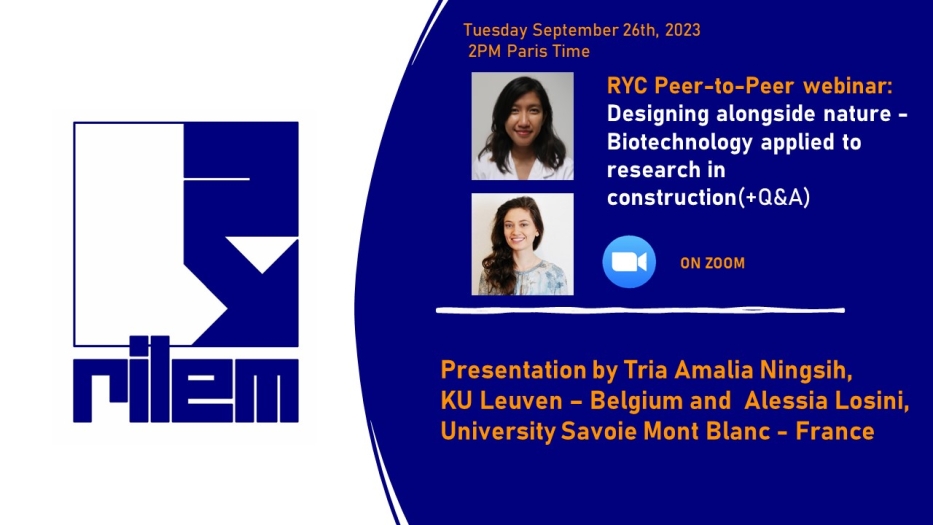Events calendar
Region : Europe

Designing alongside nature - Biotechnology applied to research in construction
The next Peer-to-Peer webinar will take place on Tuesday September 26th, 2023 at 2.00PM Paris Time and will be one hour long (2*20 minutes presentations + 15-minute interaction). The registration for this webinar is free.
Theme of the Peer-to-Peer Webinar: Designing alongside nature - Biotechnology applied to research in construction
REGISTER FOR FREE HERE.
Speaker 1: Tria Amalia Ningsih, KU Leuven, Belgium
Title: Potential of Fungal Biocomposites made from Construction and Demolition Waste
Mycelium bio composites are a compelling path of research since they are ecologically friendly
biomaterials with potential uses in building sustainably. These materials are affordable, lightweight,
and have the potential to replace traditional materials such as foam, wood, and fos sil based polymers.
Variations in composition, such as fungal species and organic matrices, as well as varied production
processes have led to materials that are ideal for packaging and interior design objectives, such as
panels, floors, and furniture. Whereas they are appraised for their biodegradability, mycelium bio
composites are susceptible to moisture and have poor mechanical endurance.
This research unfolds the cap ability of multiple fungal strains to thrive within mineral rich
environment s to en hance mycelium bio composites with mineralized matrixes. The primary
experiments were carried out to evaluate the ability of fungi to proliferate in mineral rich
environments and create the required metabolites. The experiment s w ere then extended to includ e
the production of fungal biomass in construction and demolition waste . Finally, this work
demonstrates the ability of the selected fungal strains to b ind C&D waste through their growth and
metabolite production , creating mineral based mycelium composites . This research uncover s a viable
path to produce robust and sustainable biomaterials by integrating biochemistry in architecture
Speaker 2: Alessia Losini, University Savoie Mont Blanc, France
Title: Rammed earth stabilization with waste or recycled materials and natural additives: microstructural, mechanical and hygrothermal characterization
The need to use sustainable and efficient construction materials has drawn researchers' attention to earthen heritage, appreciated for its low environmental impact, high thermal inertia and passive hygroscopic regulations. In France, the construction technique of rammed earth, locally called pisé, is particularly diffused in the region of Rhône-Alpes where it represents about 40% of rural architectural heritage. Recent investigations consider the use of biopolymers to improve the mechanical and durability properties of earth to avoid the more common use of concrete and lime. Five formulations of stabilized rammed earth were prepared with different biopolymers: lignin sulfonate, tannin, sheep wool fibers, citrus pomace and grape-seed flour. The microstructure of the different formulations was characterized by investigating the interactions between earth and stabilizers through mercury intrusion porosimetry (MIP), nitrogen sorption isotherm, powder X-ray diffraction (XRD) and scanning electron microscopy (SEM). The unconfined compressive strength (UCS) was also evaluated for all stabilized specimens. Hygrothermal characterization was also performed, including the determination of sorption isotherm at different temperatures, water vapor permeability by wet and dry-cup, thermal conductivity at different moisture content via Hot-Disk, and moisture buffer value MBV. Three out of five biopolymers were considered suitable as rammed earth stabilizers. The use of wool increased the UCS by 6%, probably thanks to the combined effect of the length of the fibers and the roughness of their surfaces, which gives a contribution in binding clay particles higher than citrus and grape-seed flour. Lignin sulfonate and tannin increased the UCS by 38% and 13%, respectively, suggesting the additives’ ability to fill pores, coat soil grains and form aggregates; this capability is confirmed by the reduction in the specific surface area. Concerning hygrothermal tests, thermal conductivity was increased by 30% when using lignin sulfonate, while tannins mainly increased hysteresis. Both using tannins and lignin sulfonate was reduced the MBV compared to unstabilized samples. Conversely, the use of sheep wool fibers did not significantly modified the hygrothermal properties.
This webinar is brought to you by the RILEM Youth Council (RYC) and is hosted by Magda Posani, RYC Europe representative.
No comment
Log in to post comment. Log in.





